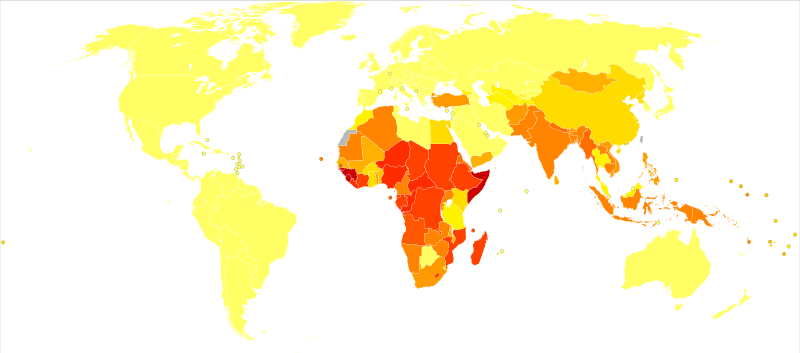So it is just one step on to inferring that wiping out the disease makes it easier for Illegal Immigrants. Is this unjustified, paranoia? We know that after the very recent [ May 2013 ] Woolwich Massacre our wonderful prime minister, Cameron chose to allege that the brutal attack on a British soldier in Woolwich on Wednesday was a "betrayal of Islam", as he urged people to go about their normal lives and not make any "knee-jerk" reactions - see Cameron Claims Woolwich Murder Betrays Islam, Cameron Lies In His Teeth. It is clear that Cameron has every intention of importing more Islamic crazies. Is he acting in our interests, an agent of a foreign power being manipulated by the Puppet Masters? By their fruit shall Ye know them.
Measles MapMeasles ex Wiki
QUOTE
Measles (also known as rubeola [not to be confused with rubella], morbilli, or English measles) is an infection of the respiratory system caused by a virus, specifically a paramyxovirus of the genus Morbillivirus. Morbilliviruses, like other paramyxoviruses, are enveloped, single-stranded, negative-sense RNA viruses. Symptoms include fever, cough, runny nose, red eyes and a generalized, maculopapular, erythematous rash.Measles is spread through respiration (contact with fluids from an infected person's nose and mouth, either directly or through aerosol transmission), and is highly contagious—90% of people without immunity sharing living space with an infected person will catch it.[1] An asymptomatic incubation period occurs nine to twelve days from initial exposure.[2] The period of infectivity has not been definitively established, some saying it lasts from two to four days prior, until two to five days following the onset of the rash (i.e. four to nine days infectivity in total),[3] whereas others say it lasts from two to four days prior until the complete disappearance of the rash.[4]
There is no specific treatment for measles. Most patients with uncomplicated measles will recover with rest and supportive treatment. It is, however, important to seek medical advice if the patient becomes more unwell, as they may be developing complications. For the vast majority of healthy patients, measles is not serious; though in some cases complications may occur, which may include bronchitis, and – very rarely – panencephalitis which is usually fatal.[5]..........
Signs and Symptoms
The classical signs and symptoms of measles include four-day fevers [ the 4 D's ] and the three Cs — cough, coryza (head cold), and conjunctivitis (red eyes) — along with fever, anorexia, and rashes. The fever may reach up to 40 °C (104 °F). Koplik's spots seen inside the mouth are pathognomonic (diagnostic) for measles, but are not often seen, even in real cases of measles, because they are transient and may disappear within a day of arising.The characteristic measles rash is classically described as a generalized, maculopapular, erythematous rash that begins several days after the fever starts. It starts on the back of the ears and, after a few hours, spreads to the head and neck before spreading to cover most of the body, often causing itching. The measles rash appears two to four days after the initial symptoms and lasts for up to eight days. The rash is said to "stain", changing color from red to dark brown, before disappearing.[6]]
Complications
Complications with measles are relatively common, ranging from the relatively mild and less serious ones like diarrhea to more serious ones such as pneumonia,[7] otitis media,[8] acute encephalitis (rarely SSPE – subacute sclerosing panencephalitis),[9] and corneal ulceration (leading to corneal scarring).[10] Complications are usually more severe in adults who catch the virus.[11] The death rate in the 1920s was around 30% for measles pneumonia.[12]Between the years 1987 and 2000, the case fatality rate across the United States was three measles-attributable deaths per 1000 cases, or 0.3%. In underdeveloped nations with high rates of malnutrition and poor healthcare, fatality rates have been as high as 28%.[13] In immunocompromised patients (e.g. people with AIDS) the fatality rate is approximately 30%.[14]
UNQUOTE
The Wiki more or less confirms my thesis regarding the medical effects of the disorder, albeit making it sound more dangerous than my experience would suggest.
